This article needs additional citations for verification .(June 2011) |
 | |
| Country of origin | Indonesia |
|---|---|
The Bali pony is an ancient breed now living on the Indonesian island of Bali.
This article needs additional citations for verification .(June 2011) |
 | |
| Country of origin | Indonesia |
|---|---|
The Bali pony is an ancient breed now living on the Indonesian island of Bali.
The Bali ponies are quite hardy and self-sufficient, surviving with little outside care.[ citation needed ] They are tough animals that are not shod and are remarkably sound, with hard feet, and strong legs. [1] The ponies show the usual "primitive markings" such as a dorsal stripe, shoulder bars, and zebra stripes on the legs, in addition to their dun coat, that includes a black mane, tail, and legs. [2]
The ponies lack the traditionally "pretty" conformation,[ citation needed ] having a large and unrefined head, [1] and upright shoulder that produces short and choppy strides.[ citation needed ] The chest and back are narrow, although the neck is usually of a good length.[ citation needed ] The ponies usually range from 12–13 hands (48–52 inches, 122–132 cm). [2] Both the conformation and the coloration produce a pony that looks similar to the Przewalski's Horse.
It is possible that ancient stocks were brought to Indonesia by the Chinese Tang dynasty in the 7th century, recorded as being given to Dja-va (Kalingga kingdom), Dva-ha-la, and Dva-pa-tan (Bali). Mongolian horses are probably captured during the Mongol invasion of Java (1293). If this true, the Java pony would owe much of its roots to the Mongolian horse as well as horses obtained from other areas of western Asia like India and Turkmenistan. [3] : 14 [4] : 60 [5]
In addition to the Mongolian horse, it is known that some Indian stock were taken to Indonesia (although it is unknown exactly which breeds), [1] and the Dutch also brought various eastern breeds to the country during the 18th century. Therefore, the Bali pony likely has been influenced by both the Mongolian horse, and various other eastern breeds.
The Bali pony has not been selectively bred for any particular set of characteristics. However, they easily perform the tasks required by the native people, including carting coral and stones from the beach. Their strength has also made them a popular mount for trekking and sightseeing tourists. [2]
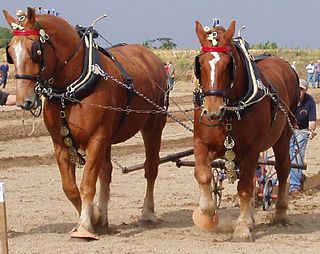
The Suffolk Horse, also historically known as the Suffolk Punch or Suffolk Sorrel, is an English breed of draught horse. The first part of the name is from the county of Suffolk in East Anglia, and the word "Punch" is an old English word for a short stout person. It is a heavy draught horse which is always chestnut in colour, traditionally spelled "chesnut". Suffolk Punches are known as good doers, and tend to have energetic gaits.

The Russian Don is a breed of horse developed in and named after the steppes region of Russia where the Don River flows. Utilized originally as cavalry horses for the Cossacks, they are currently used for under-saddle work and driving.
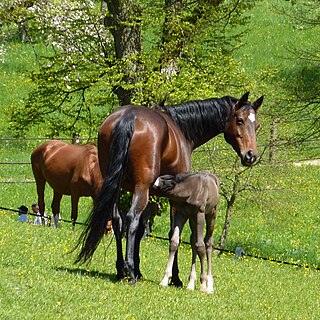
The Württemberger, Baden-Württemberger or Württemberg is a Warmblood horse breed originating in Germany. They are primarily riding horses, and are selectively bred for dressage and show jumping.

The Dole Gudbrandsdal, Dølahest, or Dole is a draft- and harness-type horse from Norway. The Dole Trotter is alternately considered a subtype of the Dole Gudbrandsdal and a separate breed; it is also considered a part of the coldblood trotter type. The Dole Gudbrandsdal is a small draft horse, known for its pulling power and agility, while the Dole Trotter is a smaller, faster horse used for harness racing; the two types are commonly interbred. Both types are strictly critiqued before entry into the studbook, which has over time resulted in an improvement in the breed type. The Dole is originally from the Gudbrandsdal Valley, and is probably descended in part from the Friesian horse. Over time, the breed has had Thoroughbred, Arabian, and other breeds added in, especially during the creation of the Dole Trotter in the 19th century. The first studbook was created in 1941, and the current breed association was formed in 1947. Although originally used mainly as a pack horse, today, the heavier Dole type is used mainly for agricultural purposes. The Dole Gudbrandsdal been crossed with other breeds to develop horses for harness racing and riding.
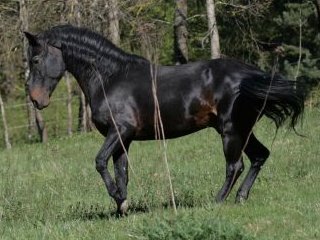
The Kabarda, Kabardin or Circassian horse is a breed from the Caucasus, originating from Eastern Circassia, currently part of the Kabardino-Balkaria region of Russia. These horses are noted for their endurance and ease to adapt in difficult environments.

The Ardennais or Ardennes is one of the oldest breeds of draft horse, and originates from the Ardennes area in Belgium, Luxembourg, and France. They are heavy-boned with thick legs and are used for draft work.

The Budyonny is a breed of horse from Russia. It was bred as a military horse after the Russian Revolution of 1917; in the twenty-first century it is used as an all-purpose competition horse and for driving.
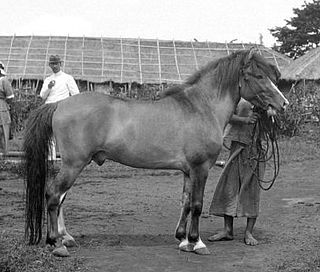
The Batak pony, also called the Deli pony, is a pony breed from Indonesia. Originating in Central Sumatra, it is thought to have descended from Mongolian Horse and Arabian blood, and has continually been infused with additional Arabian blood to improve its quality. The Batak is selectively breed by the Indonesians, and is often used to upgrade the quality of the horses and ponies on nearby islands.
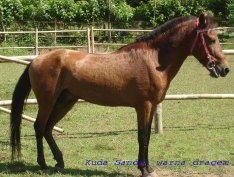
The Sandalwood Pony is a breed of small horse originating from Indonesia, on the Sumba and Sumbawa Islands. It is named after the Sandalwood trees, which are a major export of the country. The Sandalwood pony is one of the finest in the country, partly due to the great amount of Arabian blood. They make suitable children's ponies, and have been exported to Australia for this purpose. They have also been exported to other Southeast Asian countries for use as racing ponies.

The Sumbawa Pony is a pony breed, named after the island on which they are bred, Sumbawa Island in Indonesia. This breed is very similar to the Sumba or Sandalwood Pony, a breed also developed in these islands, which came from crossing the native ponies on horses of Arabian breeding. The Sumbawa Pony descends from Mongolian Horses and ancient Chinese stock
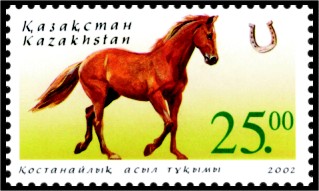
The Kustanair is a breed of horse developed in Kazakhstan in the former U.S.S.R. in the late 19th and early 20th centuries. They are used mainly for under-saddle and light draft work.

The Lithuanian Heavy Draught is a draught horse breed created in Lithuania during the 19th and 20th centuries. They are used mainly for heavy draught and farm work, as well as meat production and the improvement of other breeds. The breed is currently near extinction..

The French Saddle Pony, also called the Poney Français de Selle, is a pony breed developed as a sport pony for children and smaller adult riders. It was initially developed in 1969 as the Poney de Croisement, and in 1972 a stud book was created. In 1991 the stud book was closed and the breed renamed to Poney Français de Selle. The breed combines a mix of French and British pony breeds, as well as Thoroughbred and Arabian blood, to create the horse seen today. Due to the large number of breeds used to create the French Saddle Pony, there is not yet a defined set of physical characteristics for the breed, although all tend to be suited for competition in English riding disciplines, including dressage, show jumping and three-day eventing. They fill a similar role as the British Riding Pony and the German riding pony.

The Italian Heavy Draft, or Rapid Heavy Draft, is a breed of draft horse from Italy. The full Italian name of the breed is Cavallo Agricolo Italiano da Tiro Pesante Rapido, "Italian Rapid Heavy Draft Farm Horse", and the abbreviation TPR ) is often used.
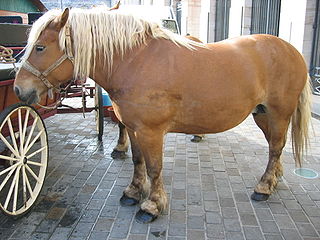
The Comtois horse is a draft horse that originated in the Jura Mountains on the border between France and Switzerland.
The Calabrese is a breed of horse originating from Italy, generally used for riding. They were developed from horses bred in Italy before the founding of Rome, and the breed has continued to be developed to the present day through infusions of Arabian, Andalusian and Thoroughbred blood.

The Kazakh Horse is a horse breed of the Kazakh people, who live mainly in Kazakhstan, but also in parts of China, Mongolia, Russia and Uzbekistan. It is used mainly as a riding horse, and is known for its hardiness and stamina.

The Java pony is a breed of pony developed on the island of Java in Indonesia. It is thought to have descended from wild forebears of Mongolian Wild Horse ancestry. It is larger and stronger than the Timor pony, with more Arabian breed influence.
The Gayoe, also known as the kuda-Gayo, is a pony from the island of Sumatra, found near Aceh. The name is derived from the Gayoe hills in the north of the island.
The Karacabey horse is a now-extinct horse breed. It was a light riding horse that originated in Turkey.